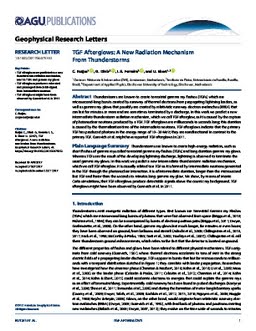2017-10-28
TGF afterglows: A new radiation mechanism from thunderstorms
Publication
Publication
Geophysical Research Letters , Volume 44 - Issue 20 p. 10702- 10712
Thunderstorms are known to create terrestrial gamma ray flashes (TGFs) which are microsecond-long bursts created by runaway of thermal electrons from propagating lightning leaders, as well as gamma ray glows that possibly are created by relativistic runaway electron avalanches (RREA) that can last for minutes or more and are sometimes terminated by a discharge. In this work we predict a new intermediate thunderstorm radiation mechanism, which we call TGF afterglow, as it is caused by the capture of photonuclear neutrons produced by a TGF. TGF afterglows are milliseconds to seconds long; this duration is caused by the thermalization time of the intermediate neutrons. TGF afterglows indicate that the primary TGF has produced photons in the energy range of 10-30 MeV; they are nondirectional in contrast to the primary TGF. Gurevich et al. might have reported TGF afterglows in 2011.
| Additional Metadata | |
|---|---|
| , , , , , | |
| doi.org/10.1002/2017GL075552 | |
| Geophysical Research Letters | |
| Cosmic Lightning | |
| Organisation | Centrum Wiskunde & Informatica, Amsterdam (CWI), The Netherlands |
|
Rutjes, C., Diniz, G., Ferreira, I., & Ebert, U. (2017). TGF afterglows: A new radiation mechanism from thunderstorms. Geophysical Research Letters, 44(20), 10702–10712. doi:10.1002/2017GL075552 |
|

